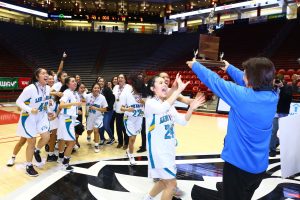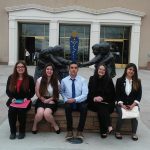LOOKING BACK ON MARCH 2020; GETTING THE CALL TO HOLD A STATE BASKETBALL TOURNAMENT WITHOUT FANS
It was Wednesday, March 11. The quarterfinals of the 2020 State Basketball Championships were underway at Dreamstyle Arena The Pit in Albuquerque, as well as the Santa Ana Star Center in Rio Rancho. Thousands of fans filled both arenas to watch the most popular annual sporting event in the state of New Mexico.
Everything appeared to be going along as planned, until one phone call turned out to be the first step to the end of high school sports for the remainder of the year.
“I received a phone call around noon or one o’clock,” said New Mexico Activities Association Director Sally Marquez. “The phone call came from the governor’s office that we had our first case of COVID in New Mexico.”
COVID-19 is an infectious disease caused by the most recently discovered coronavirus. The world was still learning about this new illness that would eventually affect hundreds of thousands of people in the country.
“At that point, New York was a hot spot for coronavirus and you’d heard what was happening in other states and we were lucky that it hadn’t hit New Mexico yet,” said Marquez. “When the governor’s office called, I thought ‘oh no, we’re going to be shut down’ because some of the other states on the east coast were being shut down. At that point, the governor was going to allow us to continue because we had already started our state basketball tournament. We were not going to have to shut down or get rid of fans, at that point. They just wanted us to be aware of what had taken place and continue with precautions.”
That was early afternoon on Wednesday.
But things would quickly change.
“I remember coming down the ramp after that phone call and I was stressed a little bit, but I realized we were going to be ok,” recalled Marquez. “We just needed to get through the tournament and not alarm everybody.”
Within the next hour, the NMAA Executive Director received another call from the governor’s office. On that call they said, ‘Sally, we might have to shut down’.
Thursday, March 12 would look a lot different.
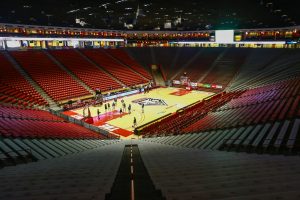
The following is a one-on-one interview with NMAA Executive Director Sally Marquez about the week that high school sports came to an abrupt stop for the rest of the year.
Question: When did the call come where they told you that they were going to shut you down?
I would say we probably started having that conversation probably somewhere around 3 or 4 in the afternoon. As we were having that conversation, I was still very hopeful that we were okay and might not have to shut down the entire tournament. I was talking to the governor’s office and also talking to Dr. Stewart, the Secretary of Education. All three of us were in communication back and forth. Coronavirus was so new. How do you handle the mass gatherings? How are you going to handle COVID-19 in the state of New Mexico? So, I think all three of us were trying to figure this out. Lieutenant Governor Howie Morales was also involved and we were all asking what do you do. It was probably about 5 o’clock when I did get the word when they said, ‘Sally, we’re going to probably have to shut you down.’ It just went to a standstill.
We were still in the middle of playing. I mean, I was at the top of the ramp in this small tiny storage room, the games are going on, nobody knows what’s happening, and I’m in this corner on my phone talking to these people. I remember sitting in this empty locker, just sitting there talking with different people, trying to make decisions. I think it’s about five or six o’clock, going back and forth when they said ‘Sally, you’re not going to have fans; we’re going to allow you continue, but you cannot have fans.’ At that point, I’m wondering how is that going to work? So, I would say, the next two to three hours, they said, ‘okay you can have 100 fans.’ How are we going to make 100 fans work? Who’s going to get to come into the Pit? How are they going to decide the team makeup and how many teams we can have in the facility? We were also dealing with Santa Ana Star Center, as well. So, it was finally given to me about 6 o’clock, I would say, I’m just kind of guesstimating, when they said, ‘You can have 100 in the facility’. When you’re talking about a hundred, keep in mind, we have 20 on each basketball team and you have two teams on the floor and two up in the locker room; there’s 80 people right there. The governor’s office was asking me, ‘Well, can you house the two teams that are about ready to play at Albuquerque High, or Cleveland High School for Santa Ana, let them warm up there, and then bus them over to the arena once the other game is done?’ Then we start talking about the Davalos Center to keep the teams before they play, but in their eyes the Davalos was the same facility as the Pit; even though it was two separate buildings, they were still connected to each other. So, we could not even put them in the Davalos Center to make it just two teams. Then you start adding maybe a little bit of parents or some media, we couldn’t figure out how the hundred was going to work. It would take about another two to three hours to figure out how we are going to make one hundred work and I remember saying since about three or four o’clock that ‘I am not going down the Pit ramp because everybody’s going to know something is going on since I haven’t shown my face in a long time.’ So, I holed up for about 6-8 hours in that one room.
Q: What was going through your mind at that point?
You have to become emotionless, I guess that’s the word. You have to become a little bit emotionless because you’ve got to put on the hat, like ‘okay, now we are going to make this work’. These are the orders that are coming down from the governor’s office and I respect the orders, and I will always respect the orders. So, now my job is to figure out how are we going to make this work, how are we going to communicate this, and the most important thing is how are we going to tell kids that it’s going to be okay and make sure that they are safe. So, yeah, there wasn’t anger, there wasn’t franticness, there was just ‘okay let’s put the hat on and let’s make this happen’. That’s what we did and that’s how we made it work.
I had to give a list to the governor’s office and the Secretary of Education as to who was going to be in the facility. Four teams, one scorekeeper, clock operator, all the essential workers. We sent most of our staff home in order to make the numbers work. We also had to figure out where to keep the officials. So, what we did is keep the officials at another site so we wouldn’t have to count them in the building for that game and then we would shuttle them over when it was time for them to officiate. I think the hardest thing was trying to figure out how are we going to deal with the number of media. I couldn’t decide that ‘this media’ can come in and ‘this one’ can’t. I did not want to be that person to make that decision as to which media could stay and which ones couldn’t in order to stay within the hundred-person limit. Ultimately, that decision was put in the hands of the New Mexico Broadcasters Association; but the first day, I said there would be no media. I look back on that and maybe I should have gone to the Broadcasters Association and the head of the print media and said, ‘let’s figure this out’. But we didn’t have that time to turn that around at all. So, it was on Thursday, that first day without fans, when we got some complaints because the media wasn’t involved. Then the governor’s office called and asked ‘How can we get media in?’ and they did extend that number to, I think it was, 104 in order to allow a print and a TV member from each team into the facility. Then we left it in the Broadcaster’s hands to make the decision as to which media outlet was going to be allowed into each game.
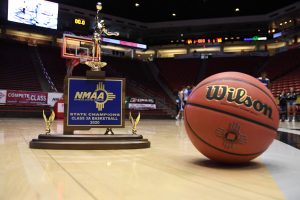
Q: What was it like walking into the Pit that next morning knowing basketball was going to be played, but without any fans?
I think I was more anxious wondering if everybody got the word there would be no fans. From 10 o’clock at night on Wednesday until 11, I had staff members calling teams to let them know that no fans were going to be able to come and the games would be streamed on the NFHS network. That was first and foremost, to make sure we got the word out in time for there not to be a line of fans at the Pit wanting to get in and buy tickets. We did meet with UNM to help with the process.
UNM was wonderful in this whole entire thing! They were right beside us making it work and they made sure we had security out there, and that the police were still out there, to make sure people were not able to access the building from the outside and be on hand in case they had to turn cars away. But they really didn’t have to turn cars away because of our communication. I think the one thing I was most proud of was getting the communication out there. It wasn’t the message they wanted to hear, but we communicated it in a way to the public where we didn’t have the fans outside picketing, screaming and yelling and trying to get in. We were just going to have to continue moving forward.
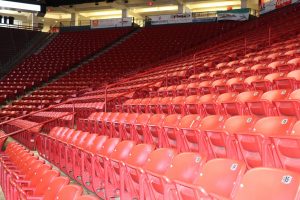
Q: At what point did you realize, the NMAA can pull this off?
You know, my personality is ‘give me a problem and we will pull it off’. I’ve never doubted myself or my team around me that we couldn’t pull it off. So, even when the governor’s office told us we couldn’t have fans, I knew we could figure out a way to make this happen. Maybe it’s my math background, but I look at a problem like a puzzle and you just have to make the pieces fit.
Q: What was the most challenging and difficult part of that puzzle?
I think the most difficult part was, as a parent and as a mom, knowing that parents were not going to be able to see their kids. I think that was probably the most difficult. Sure, you’re going to have streaming games, but it is not the same as watching your kid play. So, I think that probably was the most gut-wrenching part of it. I knew the kids were going to be okay, the coaches could handle it, the officials would be okay, but that was probably the hardest part emotionally for me, the parents not being able to see their kids, especially the senior parents.
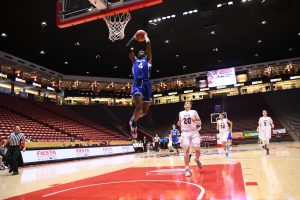
Q: You held a press conference that first night to announce to everyone there would be no fans. What do you recall about walking up to that podium to deliver that message for the first time? What was going through your mind?
An hour before the press conference, I told the governor’s office ‘I need a statement from the governor. I mean, if you guys are telling me I have to shut down, I need to be able to go in front of this media right now and tell everybody this is coming from the governor’s office.’ Nobody really understood, at that point. We haven’t had a situation like this in New Mexico. They did send me a statement and I went in there and made sure I had it in my hand before I got in front of everybody to let them know what was going on.
Q: What did you hear from the kids and coaches after the decision? What was their reaction?
So, it’s two-fold. At that time, they were thanking us for just allowing them to play. We did get a lot of thank you’s. But now that once people look back and realize what we pulled off, now that we know what COVID is, it’s not new to them, they understand where we are in our state. Several months later, I think looking back on it, it’s the ‘Wow!’, it’s the wow factor that we were just able to play and we pulled this off. People say, ‘Thank you guys, thank you for giving our kids the opportunity’. We were the last ones standing, we are one of the few States that had finished their State Basketball Championships that week. So, I think the difference is now it’s they’re shocked that we were able to do that. The kids were just excited to be able to play and the excitement of them running down the ramp was the same whether they had people in the stands or not. You know, even though there were no fans in the stands, the kids still competed just as hard as if the building was full. We had no issues with poor sportsmanship, everyone competed with class, and that was great to see. It was a very unique event that’s never been played in circumstances like this, but once the ball went up in the air, you wouldn’t know there was any difference by the play on the court. In the end, that’s what you want to see, kids respecting each other, competing with integrity, and getting the opportunity to just play.
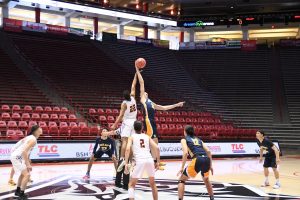
Q: Is there anything you would have done differently?
The media, I would have done that differently. Other than that, we did a good job. It’s hard for me to say that because I’m so critical of myself. But the media situation I did regret. I guess I didn’t know there were leaders in broadcasting that would be able to take that ball and run with it because they did a fantastic job on Friday and Saturday. They organized it and I didn’t have to worry about it. That’s my biggest regret. But I am proud of what we did and that we were able to pull it off. When we were putting together a list of who was allowed to be in the building, I was arguing for the media. I don’t think people know that. I was checking off people and asking the governor’s office ‘Can I go to 110? Can I go to 120 to get the media in?’ and I was given a ‘No’ and there was no way that I could see, at that time, any way I could do it. Then the governor started getting calls and ultimately let us expand it to 104. Even with just the four people, we made it work.
Q: How did this help you as a leader? What did you take away from this event?
I think first and foremost, it’s communication. If you’re closed off and you’re not accessible to answer questions, people wonder what’s happening. I think people want to know what’s going on. And when you open up and tell people ‘this is the truth’ and you’re out there so there’s no unknown, I think that helps. I pride myself on being accessible and the communication between
myself and the membership is strong. Parents call me, coaches call me directly, you know the kids could call me, I pride myself on being accessible. I think the communication piece with people from the beginning, even though people were angry at that time, the way that we were able to communicate the message and work closely with the governor’s office and the Public Education Department, made a big difference. We’re all in this together, we’re in it for kids. It’s important for people to see that you care and that you have a heart and that we are all in this together, that’s one thing that I really can take from it.
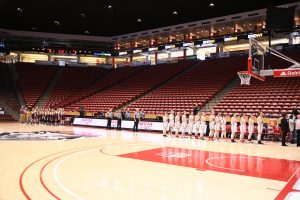
Q: Now, several months later, looking back on that day that put a stop to high school sports, how do you view the entire experience?
I look at it more that I hurt for kids, you know. Yeah, we pulled it off, but it’s about the kids. We had a lot of kids that were really just thankful that they were able to play. I remember when I was their age, before I started every game, I made sure my parents were in the stands. You go back to your playing days to compare and realize that in this state tournament they weren’t able to get that reassurance that mom and dad, or brothers or sisters, or grandparents, were in the stands before they started the game. I hurt for them because I remember being in those shoes at one time. It was a big blow when we later had to call off Spring Sports. I think that was probably the worst day in my 36, 37-year career that I ever had to do was tell the spring sport athletes that we were done.
Q: Do you think that day was the beginning of a change of sports forever?
I hope we get back. I hope it’s sooner rather than later; but in sports we teach lifelong skills and I think that we have to keep that focus, whether it’s in negative situations, positive situations, uncomfortable situations, that we’re continually teaching life skills. I think right now the focus should be education-based athletics. I do believe that with every situation, good or bad, we can always learn and we can always grow. I always say that I’m molded and shaped every single year and every single day of my life. Kids need sports and activities more than ever. It’s sad that they’re not able to do it, but the positive is that we are needed in kids’ lives. If we can get better by working hard for students in the state of New Mexico, then it’s a win-win.
